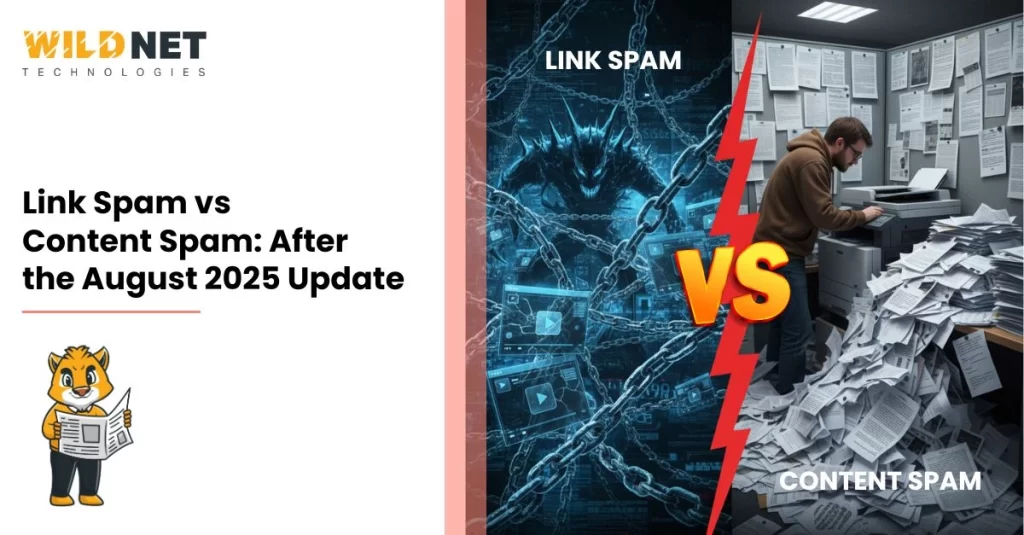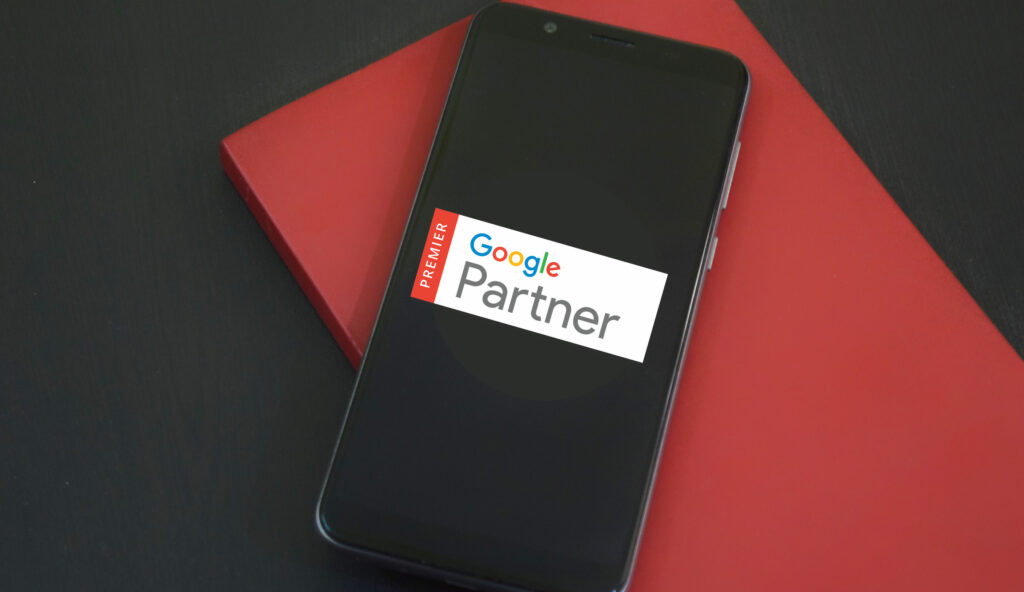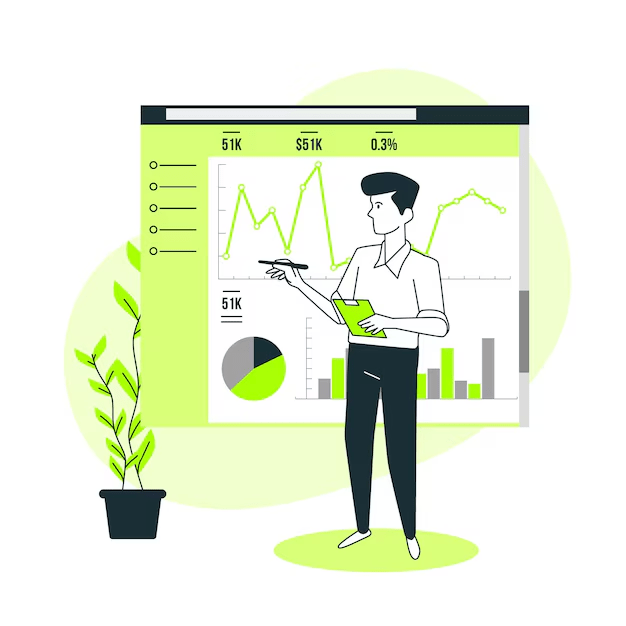Summary
The Google August Spam Update 2025 shook the internet and targeted spamming activities. Many websites took a hit, while some got deindexed, and we are here to help you understand the reason behind it.
There are two reasons: link spam and content spam. For many of us, these terms will be new jargon.
But since you can be punished for them, it is best to be aware of them, differentiate them, and finally resolve and avoid them.
If you are an average reader wondering, what if I click on a spam link or how to check link is spam or not, we have covered that as well.
Key Takeaways
- Link spam manipulates backlinks, while content spam manipulates on-page content.
- Google’s August 2025 update penalized both spam types to improve search result quality.
- Using tools such as spam link checker and content spam checker is essential to audit your site.
- Regular monitoring and ethical SEO practices can prevent future penalties.
Table of Contents
- A few facts about Spamming
- About: Link & Content Spam
- Link Spam vs Content Spam
- Google August Spam Update 2025: Link Spam vs Content Spam
- The Way Forward
- Conclusion
- FAQs
Spamming is not new, but it evolves to evade Google’s detection. The August 2025 Spam Update highlighted the growing sophistication of spam tactics, impacting both link spam vs content spam.
With millions of websites relying on SEO for visibility, even a single spam website link or low-quality spam article can have drastic consequences.
Whether you run a blog, e-commerce site, or corporate website, understanding the nuances of spam types & recovery strategies is key to maintaining traffic, rankings, and online credibility.
A few facts about Spamming
- More than 160 billion spam emails are sent every day.
- This translates to 2,184 metric tons of CO2 pollution to trap the innocent users.
- In 2025, 83% of the link building platforms use AI to reduce spammy links.
- As per Google’s Spam Policies, 16 types of spamming activities are in use.
- FYI, Google doesn’t punish bought links as long as they come with a “nofollow” or “sponsored” tag.
About: Link & Content Spam
Let’s get to know them first, and then we will understand how the recent Google update impacted them.
What is Link Spam?
Link spam refers to manipulative tactics used to artificially boost a website’s search rankings by creating or acquiring low-quality backlinks.
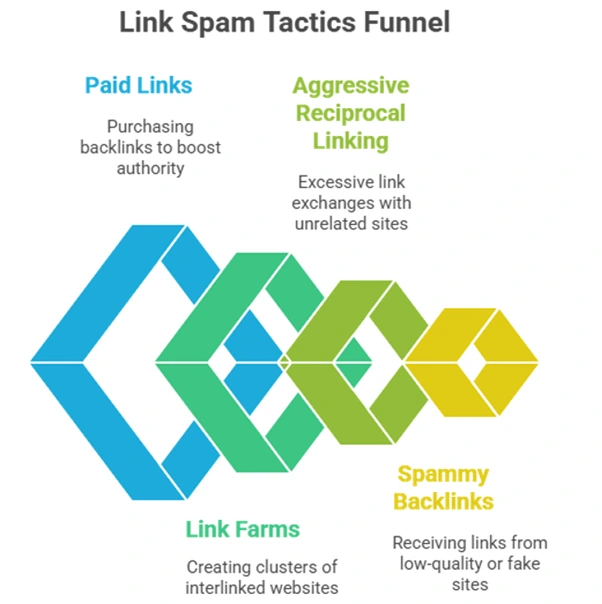
Four types of Link Spam
Its common types include:
- Paid Links: Buying backlinks to increase authority.
- Link Farms: Clusters of websites that interlink purely for SEO gain.
- Aggressive Reciprocal Linking: Excessive exchanges with unrelated websites.
- Spammy Backlinks from Low-Quality Sites: Irrelevant or fake sites linking to your domain.
Detection Tools
Here are the three ways to detect link spamming,
- Spam link checker
- Link spam checker
- Manual audits using Google Search Console
Example: A travel blog receiving 500 backlinks from unrelated tech sites is likely flagged as link spam.
Why does it matter?
Link spam can trigger Google penalties, remove pages from search results, and reduce domain authority.
What is Content Spam?
Content spam focuses on creating low-value content intended to deceive search engines rather than help users.
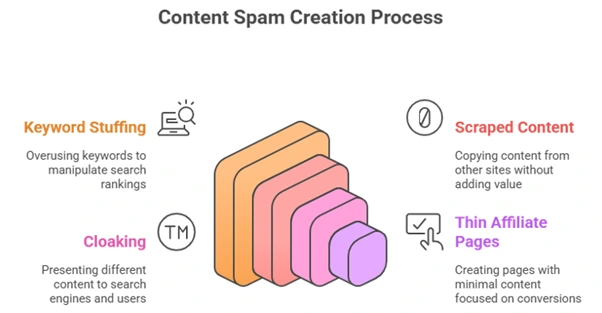
Four Key types of Content Spam
Its forms include:
- Keyword Stuffing: Excessive repetition of keywords to rank higher.
- Scraped Content: Copying content from other sites without adding value.
- Cloaking: Showing different content to search engines and visitors.
- Thin Affiliate Pages: Minimal content focused solely on conversions.
- Spam Articles, Spam Email Content, and Spam YouTube Videos
Detection Tools
The following methods can detect it,
- Content spam checker
- Google Spam Report system
- Manual review for hidden links, irrelevant content, or duplicate material
Example: An affiliate website publishing dozens of auto-generated product reviews with no real insights engages in content spam.
Now that we know what they are, let’s compare them.
Link Spam vs Content Spam
With so many websites getting penalised and removed from Google indexing, a brand cannot ignore these two spamming tactics.
All the effort that is put into branding and marketing a brand goes to waste once it loses indexing or the possibility of showing up in search results.
So, here’s the difference between the two:
| Aspect | Link Spam | Content Spam |
|---|---|---|
| Focus | Backlinks | On-page content |
| Goal | Manipulate ranking via links | Manipulate ranking via content |
| Detection Tools | Spam link checker, link check for spam & more | Content spam checker, Google spam report & more |
| Impact | Penalties and loss of domain authority | Penalties, lower rankings, and brand damage |
Link Spam vs Content Spam in 2025
Link Spam vs Content Spam Examples
Wildnet provides more examples of the two spamming methodologies to help your brand or client make the wise choice.
Link Spam Examples:
- Buying backlinks from unrelated domains
- Joining link farms or PBNs
- Posting spam website links in forums or blogs
Content Spam Examples:
- Auto-generated spam articles
- Reposting existing content without adding value
- Hidden text or keyword stuffing on high-ranking pages
We hope it helps you choose the hustle and not the hassle.
Google August Spam Update 2025: Link Spam vs Content Spam
Google’s latest spam update of 2025 took almost a month to roll out, during which time they upgraded the Spambrain AI. This AI has been helping them since 2018 to root out spamming and make the search experience worthwhile for the users.
Let’s see how it impacted the two spams in question.
Which Spam Tactic Was Hit?
Google focused on both link spam and content spam.
- Sites using spammy backlinks from unrelated domains were penalized.
- Pages relying on thin content or spam email content for ranking were hit.
- Even moderately spammy websites saw ranking fluctuations, emphasizing Google’s stricter enforcement.
So, it’s either lose ranking & get deindexed or walk Google’s user-friendly path.
What Sites Were Targeted?
If your website took a hit, check which category the website aligns with.
- Spammy sites relying heavily on automated link-building schemes.
- Websites with multiple spam website links pointing to their pages.
- Platforms publishing low-value spam articles, videos, or email content.
If your website was hit, we offer recovery.
Pro Tip
Regularly use a spam link checker to detect harmful backlinks and a content spam checker to ensure quality content.
The Way Forward
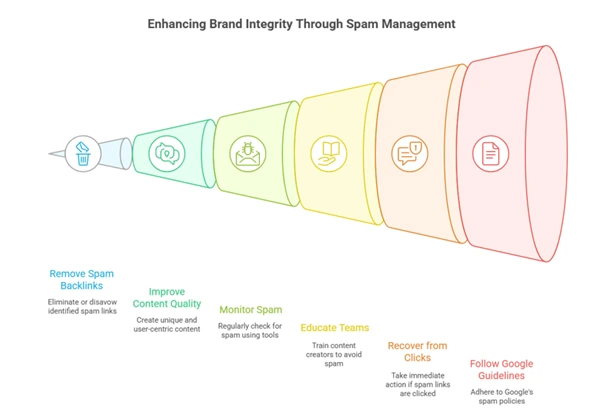
Spam-free Website: 6 Steps
Moving forward is the only possible option; here’s how your brand or client can do it.
- Audit Backlinks: Identify spammy backlinks and remove or disavow them.
- Improve Content Quality: Focus on unique, informative, and user-centric content.
- Monitor with Tools: Use a link spam checker, check spam link, or a content spam checker regularly.
- Educate Teams: Ensure all content creators know what content spam looks like and avoid automated scraping.
- Recover from Accidental Clicks: If users or admins click a suspicious link, know what to do if u click on a spam link — run antivirus and avoid sharing personal info.
- Follow Google Guidelines: Stay updated with Google’s spam policies and submit Google spam reports for detected spam sites.
If you need a reliable marketing partner, keep scrolling…
Conclusion
The August 2025 Spam Update underscores the need for ethical SEO practices.
By distinguishing between link spam vs content spam, auditing backlinks, and maintaining high-quality content, website owners can safeguard their rankings & avoid penalties.
Leveraging tools like spam link checker and content spam checker ensures continuous compliance & long-term SEO health.
Wishing your visitors a spam-free digital presence..
Wildnet Technologies is a reliable digital marketing company that has taken its 4100+ clients to the top via spam-free marketing and AI powerups.
Wish to know more?
- Google August Spam Update 2025: Done & Dusted (Rolled Out)
- Core Update, Core Chaos: What Marketers Must Do Now?
- Glossary (Because sometimes You need to dominate)
- Digital Yum (Free upskilling every week)
Connect with us at info[@]wildnettechnologies.com and get the best Marketing in 2025 & beyond.
FAQs
Question 1: How do I know if my website has link spam issues?
Answer 1: Run a site audit using a spam link checker or Google Search Console. Look for spammy backlinks from irrelevant or low-quality domains.
Remove them as soon as possible.
Question 2: What are real-world examples of content spam?
Answer 2: Examples include spam articles with keyword stuffing, spam YouTube videos with misleading titles, and auto-generated spam email content.
In other words, content that is added to look authentic and knowledgeable without actually imparting any useful information.
Question 3: What should I do if I click on a spam link by mistake?
Answer 3: Don’t panic—disconnect from the internet, clear browser data, and run antivirus software.
Knowing what to do if you accidentally open a spam link can prevent bigger issues. So be alert and educate all the team members about it.
Question 4: Can Google penalties from link spam vs content spam be recovered?
Answer 4: Yes. Clean up spammy backlinks, remove low-quality content, and submit a reconsideration request via the Google spam report process.
It might take some time to be processed, so be patient and stay true to your audience.
Question 5: How long does it take to recover from a Google spam penalty?
Answer 5: Recovery varies. Recovery may take weeks for minor issues such as a few spam website links. Heavy link spam vs content spam penalties can take several months, depending on cleanup efforts and Google’s re-crawling speed.
Question 6: How to check link is spam or not?
Answer 6: Use a spam link checker or link spam checker to analyze a URL’s trust score and source.
- Spammy links usually come from irrelevant or low-authority sites.
- Look for over-optimized anchor text or links from spammy websites.
- Check if the site has thin or duplicate spam articles.
When in doubt, avoid clicking on the link and report it via the Google spam report tool.
